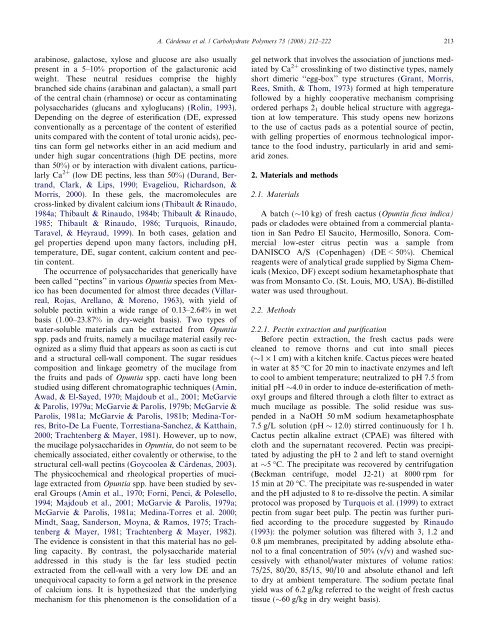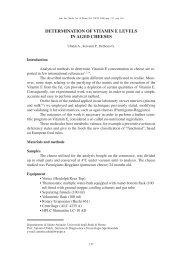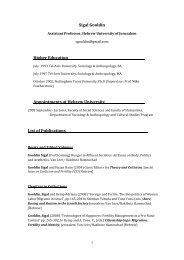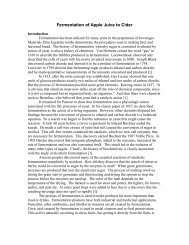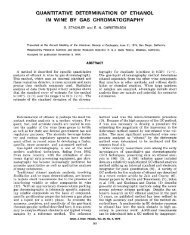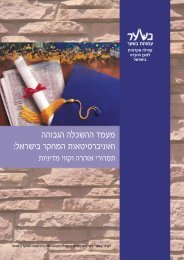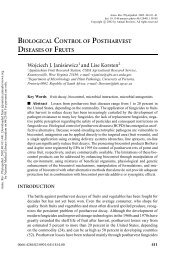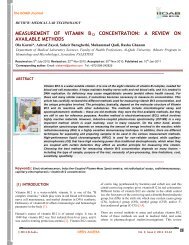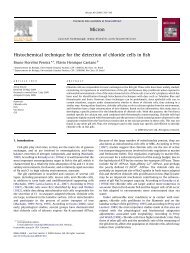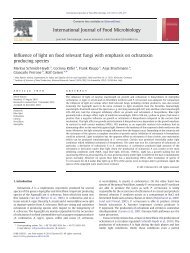On the gelling behaviour of 'nopal' (Opuntia ficus indica) low ...
On the gelling behaviour of 'nopal' (Opuntia ficus indica) low ...
On the gelling behaviour of 'nopal' (Opuntia ficus indica) low ...
You also want an ePaper? Increase the reach of your titles
YUMPU automatically turns print PDFs into web optimized ePapers that Google loves.
arabinose, galactose, xylose and glucose are also usually<br />
present in a 5–10% proportion <strong>of</strong> <strong>the</strong> galacturonic acid<br />
weight. These neutral residues comprise <strong>the</strong> highly<br />
branched side chains (arabinan and galactan), a small part<br />
<strong>of</strong> <strong>the</strong> central chain (rhamnose) or occur as contaminating<br />
polysaccharides (glucans and xyloglucans) (Rolin, 1993).<br />
Depending on <strong>the</strong> degree <strong>of</strong> esterification (DE, expressed<br />
conventionally as a percentage <strong>of</strong> <strong>the</strong> content <strong>of</strong> esterified<br />
units compared with <strong>the</strong> content <strong>of</strong> total uronic acids), pectins<br />
can form gel networks ei<strong>the</strong>r in an acid medium and<br />
under high sugar concentrations (high DE pectins, more<br />
than 50%) or by interaction with divalent cations, particularly<br />
Ca 2+ (<strong>low</strong> DE pectins, less than 50%) (Durand, Bertrand,<br />
Clark, & Lips, 1990; Evageliou, Richardson, &<br />
Morris, 2000). In <strong>the</strong>se gels, <strong>the</strong> macromolecules are<br />
cross-linked by divalent calcium ions (Thibault & Rinaudo,<br />
1984a; Thibault & Rinaudo, 1984b; Thibault & Rinaudo,<br />
1985; Thibault & Rinaudo, 1986; Turquois, Rinaudo,<br />
Taravel, & Heyraud, 1999). In both cases, gelation and<br />
gel properties depend upon many factors, including pH,<br />
temperature, DE, sugar content, calcium content and pectin<br />
content.<br />
The occurrence <strong>of</strong> polysaccharides that generically have<br />
been called ‘‘pectins’’ in various <strong>Opuntia</strong> species from Mexico<br />
has been documented for almost three decades (Villarreal,<br />
Rojas, Arellano, & Moreno, 1963), with yield <strong>of</strong><br />
soluble pectin within a wide range <strong>of</strong> 0.13–2.64% in wet<br />
basis (1.00–23.87% in dry-weight basis). Two types <strong>of</strong><br />
water-soluble materials can be extracted from <strong>Opuntia</strong><br />
spp. pads and fruits, namely a mucilage material easily recognized<br />
as a slimy fluid that appears as soon as cacti is cut<br />
and a structural cell-wall component. The sugar residues<br />
composition and linkage geometry <strong>of</strong> <strong>the</strong> mucilage from<br />
<strong>the</strong> fruits and pads <strong>of</strong> <strong>Opuntia</strong> spp. cacti have long been<br />
studied using different chromatographic techniques (Amin,<br />
Awad, & El-Sayed, 1970; Majdoub et al., 2001; McGarvie<br />
& Parolis, 1979a; McGarvie & Parolis, 1979b; McGarvie &<br />
Parolis, 1981a; McGarvie & Parolis, 1981b; Medina-Torres,<br />
Brito-De La Fuente, Torrestiana-Sanchez, & Katthain,<br />
2000; Trachtenberg & Mayer, 1981). However, up to now,<br />
<strong>the</strong> mucilage polysaccharides in <strong>Opuntia</strong>, do not seem to be<br />
chemically associated, ei<strong>the</strong>r covalently or o<strong>the</strong>rwise, to <strong>the</strong><br />
structural cell-wall pectins (Goycoolea & Cárdenas, 2003).<br />
The physicochemical and rheological properties <strong>of</strong> mucilage<br />
extracted from <strong>Opuntia</strong> spp. have been studied by several<br />
Groups (Amin et al., 1970; Forni, Penci, & Polesello,<br />
1994; Majdoub et al., 2001; McGarvie & Parolis, 1979a;<br />
McGarvie & Parolis, 1981a; Medina-Torres et al. 2000;<br />
Mindt, Saag, Sanderson, Moyna, & Ramos, 1975; Trachtenberg<br />
& Mayer, 1981; Trachtenberg & Mayer, 1982).<br />
The evidence is consistent in that this material has no <strong>gelling</strong><br />
capacity. By contrast, <strong>the</strong> polysaccharide material<br />
addressed in this study is <strong>the</strong> far less studied pectin<br />
extracted from <strong>the</strong> cell-wall with a very <strong>low</strong> DE and an<br />
unequivocal capacity to form a gel network in <strong>the</strong> presence<br />
<strong>of</strong> calcium ions. It is hypo<strong>the</strong>sized that <strong>the</strong> underlying<br />
mechanism for this phenomenon is <strong>the</strong> consolidation <strong>of</strong> a<br />
A. Cárdenas et al. / Carbohydrate Polymers 73 (2008) 212–222 213<br />
gel network that involves <strong>the</strong> association <strong>of</strong> junctions mediated<br />
by Ca 2+ crosslinking <strong>of</strong> two distinctive types, namely<br />
short dimeric ‘‘egg-box’’ type structures (Grant, Morris,<br />
Rees, Smith, & Thom, 1973) formed at high temperature<br />
fol<strong>low</strong>ed by a highly cooperative mechanism comprising<br />
ordered perhaps 21 double helical structure with aggregation<br />
at <strong>low</strong> temperature. This study opens new horizons<br />
to <strong>the</strong> use <strong>of</strong> cactus pads as a potential source <strong>of</strong> pectin,<br />
with <strong>gelling</strong> properties <strong>of</strong> enormous technological importance<br />
to <strong>the</strong> food industry, particularly in arid and semiarid<br />
zones.<br />
2. Materials and methods<br />
2.1. Materials<br />
A batch ( 10 kg) <strong>of</strong> fresh cactus (<strong>Opuntia</strong> <strong>ficus</strong> <strong>indica</strong>)<br />
pads or cladodes were obtained from a commercial plantation<br />
in San Pedro El Saucito, Hermosillo, Sonora. Commercial<br />
<strong>low</strong>-ester citrus pectin was a sample from<br />
DANISCO A/S (Copenhagen) (DE < 50%). Chemical<br />
reagents were <strong>of</strong> analytical grade supplied by Sigma Chemicals<br />
(Mexico, DF) except sodium hexametaphosphate that<br />
was from Monsanto Co. (St. Louis, MO, USA). Bi-distilled<br />
water was used throughout.<br />
2.2. Methods<br />
2.2.1. Pectin extraction and purification<br />
Before pectin extraction, <strong>the</strong> fresh cactus pads were<br />
cleaned to remove thorns and cut into small pieces<br />
( 1 · 1 cm) with a kitchen knife. Cactus pieces were heated<br />
in water at 85 °C for 20 min to inactivate enzymes and left<br />
to cool to ambient temperature; neutralized to pH 7.5 from<br />
initial pH 4.0 in order to induce de-esterification <strong>of</strong> methoxyl<br />
groups and filtered through a cloth filter to extract as<br />
much mucilage as possible. The solid residue was suspended<br />
in a NaOH 50 mM sodium hexametaphosphate<br />
7.5 g/L solution (pH 12.0) stirred continuously for 1 h.<br />
Cactus pectin alkaline extract (CPAE) was filtered with<br />
cloth and <strong>the</strong> supernatant recovered. Pectin was precipitated<br />
by adjusting <strong>the</strong> pH to 2 and left to stand overnight<br />
at 5 °C. The precipitate was recovered by centrifugation<br />
(Beckman centrifuge, model J2-21) at 8000 rpm for<br />
15 min at 20 °C. The precipitate was re-suspended in water<br />
and <strong>the</strong> pH adjusted to 8 to re-dissolve <strong>the</strong> pectin. A similar<br />
protocol was proposed by Turquois et al. (1999) to extract<br />
pectin from sugar beet pulp. The pectin was fur<strong>the</strong>r purified<br />
according to <strong>the</strong> procedure suggested by Rinaudo<br />
(1993): <strong>the</strong> polymer solution was filtered with 3, 1.2 and<br />
0.8 lm membranes, precipitated by adding absolute ethanol<br />
to a final concentration <strong>of</strong> 50% (v/v) and washed successively<br />
with ethanol/water mixtures <strong>of</strong> volume ratios:<br />
75/25, 80/20, 85/15, 90/10 and absolute ethanol and left<br />
to dry at ambient temperature. The sodium pectate final<br />
yield was <strong>of</strong> 6.2 g/kg referred to <strong>the</strong> weight <strong>of</strong> fresh cactus<br />
tissue ( 60 g/kg in dry weight basis).


